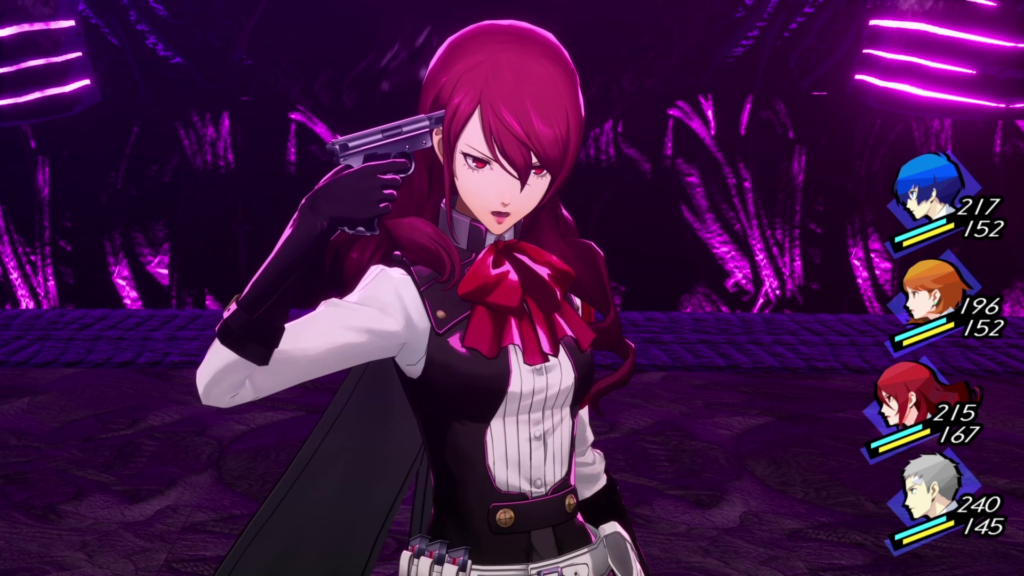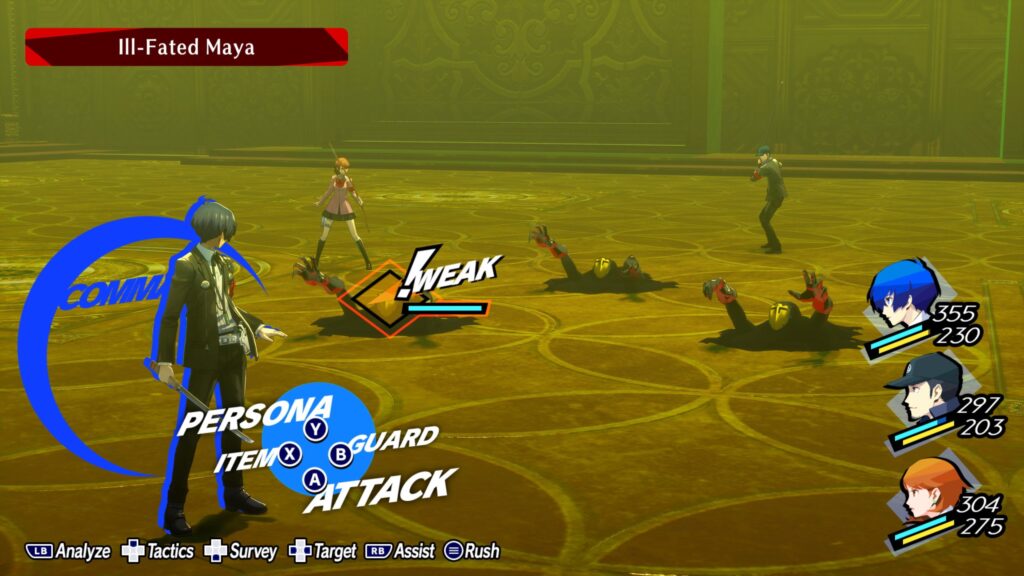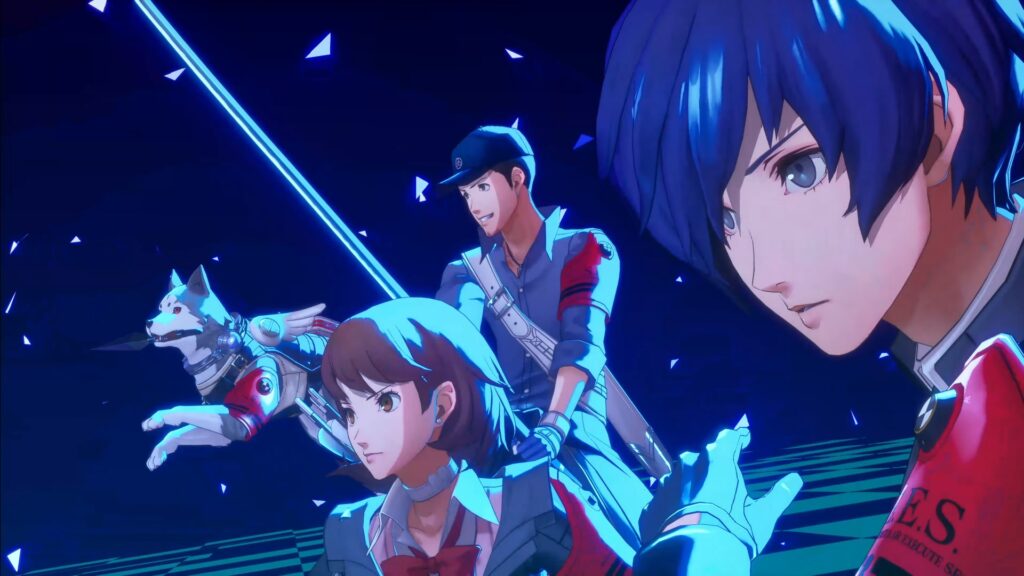Persona 3 represented an interesting crossroads for the series as a whole. At this point, the mainline Shin Megami Tensei series maintained a much larger audience than its spin-off series. This was also the first title in what many might consider the MODERN Persona series, changing a vast amount of gameplay elements including the creation of the now iconic social link mechanic.
Some people have come to label Persona 3 as the darkest take on the series, forgetting that the two before it were still full horror games, something that this game began to move the spin-off away from slowly. However, compared to its sequels, this is by far the closest to those roots.
In this regard, Person 3 Reload serves to highlight all of these aspects of a game stuck between two ideas and yet managing to shine in both. An emotional, character-driven experience that pays homage to the world-ending demonic nightmares that came before. Unfortunately, while all these aspects will remind you how much you love the series, there is plenty there to remind you this experience is now 18 years old. The fresh coat of paint and new parts make for an experience that feels new, there is always something there to break that emersion.

So I Pulled Out My Gun And Started Blasting
One of the smartest decisions Atlus ever made was never attempting to replicate the iconic opening to Persona 3 in any of its sequels and for good reason. The first time we enter the game we see a young girl holding a gun to her head, willing herself to pull the trigger, a dark moment to be sure made all the better through the game’s updated visuals. From there these opening moments manage to still up the ante with the nameable protagonist walking along a street filled with bloody coffins.
In all fairness, Persona 3 always featured my favorite story in the entire series thus far, and Reload only served the much-needed purpose of reminding me why. For those unfamiliar with the formula, or in need of a refresher, you play as a transfer student who arrives at Tatsumi Port Island and is dragged into world-altering events involving a mysterious hour that only a select few experience after midnight.
With this aim, you are recruited into the Specialized Extracurricular Execution Squad, or S.E.E.S, to explore a sprawling dungeon every night. At its core though, Persona is a social life sim in which the player actively makes day-to-day choices on how to spend your time. These choices range from hanging with your friends, going out to eat, or going to the dungeon so you can make more progress.
Each one of these aspects feeds into elements that advance your character on his journey. Eating a large meal at the burger restaurant takes courage so you you improve your courage to do it, by spending time studying you increase your academics, and by advancing social links blend with the Persona mechanic to help you advance in your quest.
Arguably the best improvement in this regard is the voice acting. While the game always had voice acting for its main cast, all social links are also voiced. Since these games always nail their voice-casting choices this is a welcomed addition that hopefully continues in the future.
Persona 3 has one of the best casts in the series in general, even without any voice acting, though bolstered by it. The main cast is given a more modern presentation through updated visuals that feel… well, like you remembered them even if your memory is wrong.
Where the game stumbles is the fact that Persona 3 Reload is not the first rerelease of Persona 3 we have gotten as we had previously received F.E.S. and Portable, with Portable probably being the one most fans are familiar with. Honestly, I could stomach the lack of Portable elements in the game such as the female protagonist even if I get why she is missed, but it’s the lack of F.E.S elements that is a gut punch.
F.E.S. served as an updated version akin to Persona 5 Royal, which added a few features and narrative bits. More importantly, though, it addressed the negative reaction to the abrupt and unsatisfying ending of Persona 3 by adding what many consider to be the true ending to the game. It’s an odd choice to remake the game and leave out the definitive elements, but here we are. Make no mistake, this is a remake of the original Persona 3 and ignores everything else.

A Night In Tartarus
The gameplay has received a significant overhaul from even the most updated port of Persona 3 to date. This starts with the turn-based combat that is brought with Persona 5, while others feel brought further still and potentially an indicator for future entries. Combat itself features the physical attack now automatic with the selection, only involving more menus if you plan to use spells. In regards to spells, you can quickly identify found weaknesses and exploit them with only a button press or two.
The biggest change to the formula is a special move that characters can use to deal larger damage. This has become a modern feature in almost every game, but Persona finds a way to implement it in a way that doesn’t break combat, which is impressive as many RPG games have struggled with this.
One of the first elements introduced in the game that kinda irked me was the heavy use of fixed cameras throughout the game. The main dungeon, Tartarus doesn’t use any thankfully but most of the main areas around town still do. Furthermore, in most cases, these fixed angles are identical to previous releases. I know the previous entry used some too, but not to the degree this one does, and also that was 8 years ago. It’s one of the more glaring examples that portions of these games are going to feel dated, which the case of many remakes recently just isn’t the case.
Character models also play victim to this in several areas. The biggest example of this is the Night Club in the Mall you eventually unlock. While a few characters in there can be spoken to have animation, there is an entire dance floor of static character models that just idle in various poses of dance. This also is something I have seen companies with far less of an audience that Atlus handle with more care.
Thankfully, the main dungeon Tartarous does not have these issues. Tartarus has a full camera that follows behind your character as you explore. The dungeon is procedurally generated so each run is unique, which is good because unlike the future entries exploration takes place at night when there is much less to do. This means there are probably plenty of nights you will just want to farm because there is nothing to do so you will see the inside of it a lot.
Area models in Tartarus have also received a massive overhaul, feeling more Lovecraftian, which plays into the horror themes quite nicely. There are also times you go outside the dungeon to face bosses and I was surprised how much I liked these areas. The first core boss, which saw you move through a train car by car was a perfect setup for what was to come. The drawback, while these bosses received overhaul they pail in comparison to Persona 5‘s dynamic bosses. If we are being fair, these are moments the Reload stumbled on the most with the idea of updating the game.
Personas don’t get an upgrade compared to other elements, they simply carry the updates that have been added over the years. You have your fusions and special fusions that are streamlined, as well as the spell using. Here though, if you have ever touched a Persona or Shin Megami Tensei game you will feel right at home, not that that is a bad thing.

Verdict
Persona 3 Reload doesn’t change its best aspect, the story, at all. Even if you played the original in 2007, F.E.S. in 2008, or Portable in 2010, there is never a point at which it lacks impact and depth. Persona 3 is regarded as one of the best games the series has to offer for a reason, and if this is your first time you are in for a treat.
Where the game did choose to make changes, they were smart and calculated. Overhauls to the combat feel new, even by the franchise’s most recent standards, and it is fun as hell. The visual upgrades across all areas also help heighten the experience, making your time across mundane school-like and dungeon-crawling super teen a joy to play through.
Where the game falters, is where the promise of a full remake falls short. Fixed camera angles in many areas hold back that experience and make the depth that was created for these areas in Reload. Several character models also showcase the game’s dated bones, feeling out of place. It doesn’t drag the experience down, but it showcases shortcuts that were taken.
The game’s biggest sin is not incorporating the F.E.S.’s true ending. Some people would argue that Persona 3 Portables’ female main character, but I would disagree. Portable had half the gameplay cut in exchange for a large amount of changed dialog, and it also cut out F.E.S.s ending. It’s a weird choice to never use that ending despite allowing the anime to make it canon.
Despite any flaws that the game does have, it succeeds far more than it fails and that is important. It makes me want to go the distance, the next floor, the next social link, the next day, till the world ends. I can think of many new features I hope to stay part of the series, and I even hope to appear in Metaphor Re:Fatazia, Atlus’ next title which will also be released this year.
Persona 3 Reload is at worst, everything you love about the series, and at best an RPG to be played for years to come.
Follow us on social media to keep up to date with everything happening at PixelByte Gaming.
Reviewed for PlayStation 5, also available on PlayStation 4, Xbox One, Xbox Series S/X, and PC
A code was provided by Sega of America for the purposes of this review.
Developer: Atlus
Publisher: Sega
Release Date: February 2, 2024
School can be hard, especially when you need to balance it with saving the world from an impending apocalypse.
Pros:
+Story and Performances
+Visual Updates
+Overhauled combat
+Quality of Life Updates
Cons:
-Fixed Camera Angles
-Some dated animations
-Lack of F.E.S. content
-
Persona 3 Reload